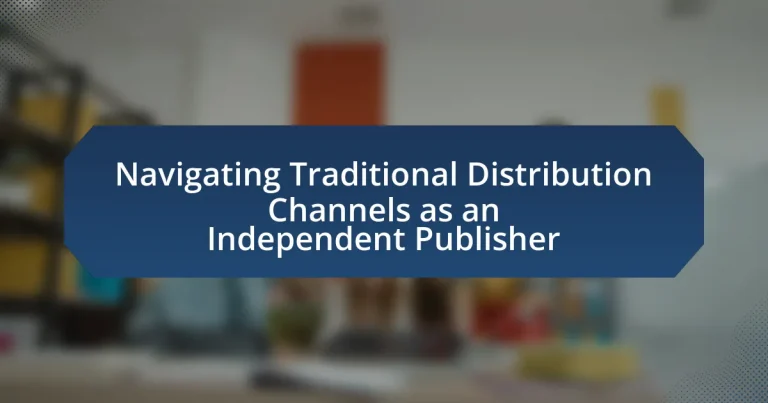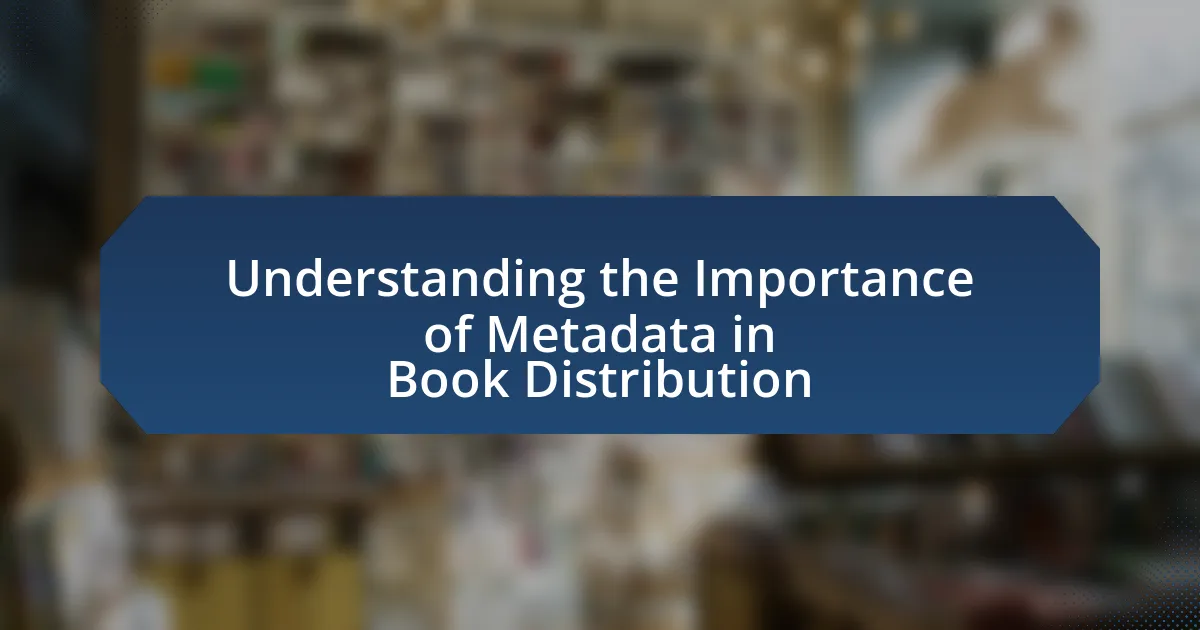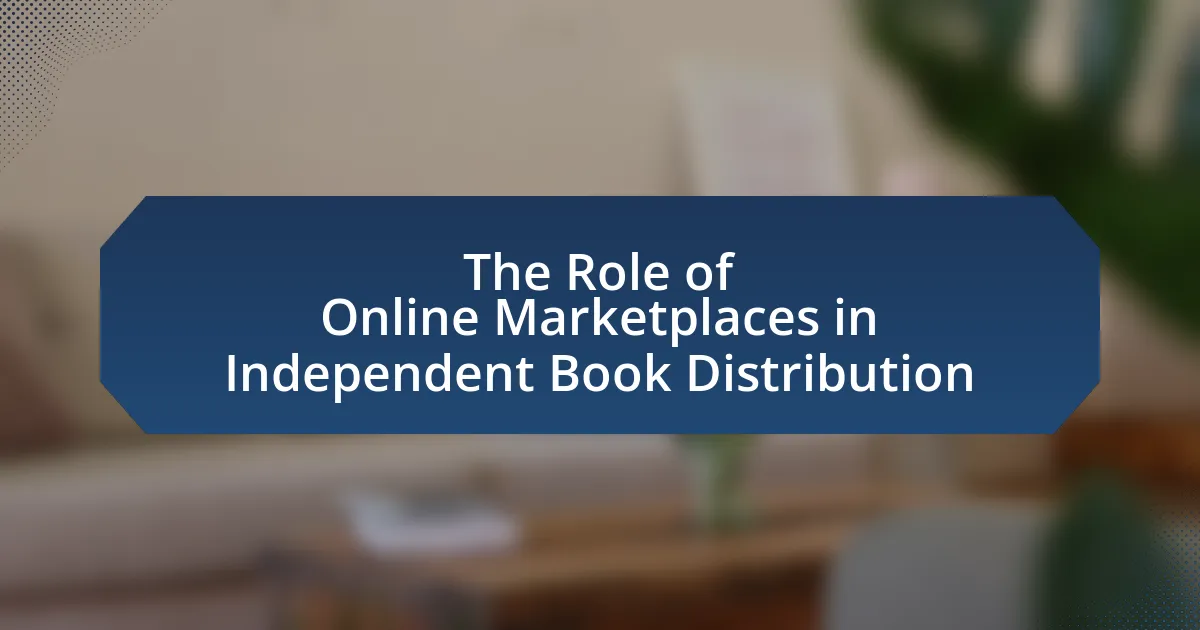The article focuses on navigating traditional distribution channels for independent publishers, highlighting key avenues such as bookstores, libraries, wholesalers, and direct sales. It contrasts these traditional methods with modern distribution strategies, emphasizing the importance of physical presence and established relationships in reaching diverse audiences. The article also addresses the challenges independent publishers face, including limited access to major retail channels and resource constraints, while offering strategies for optimizing distribution efforts through relationship building and targeted marketing. Additionally, it explores future trends influenced by technology and changing consumer behaviors, providing practical tips for enhancing distribution success.
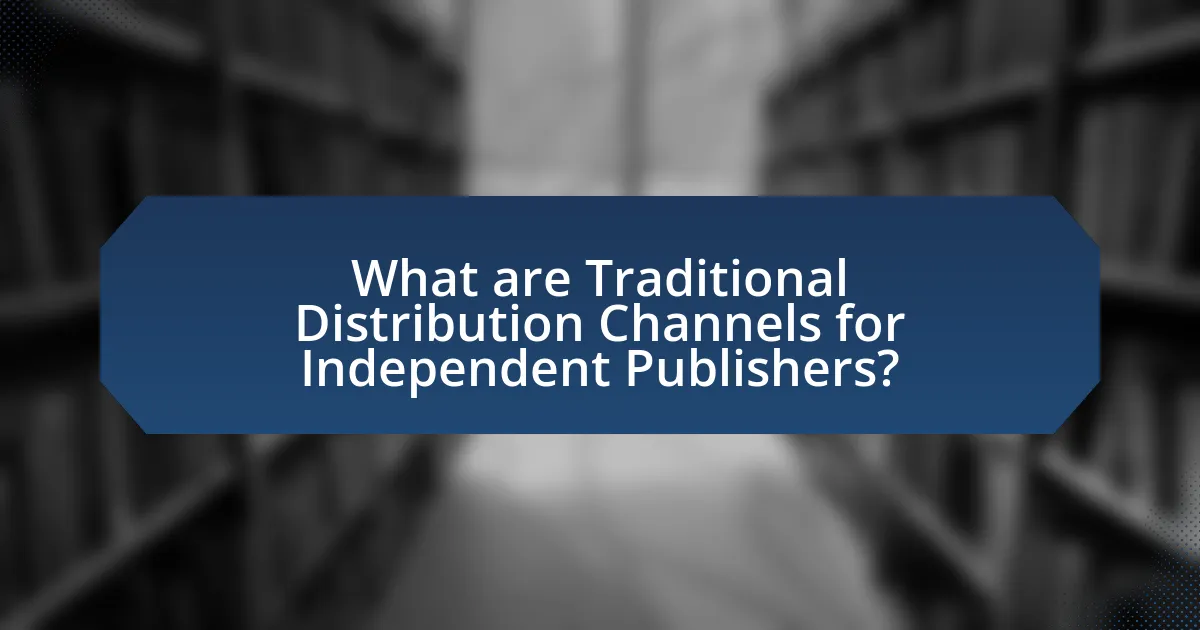
What are Traditional Distribution Channels for Independent Publishers?
Traditional distribution channels for independent publishers include bookstores, libraries, wholesalers, and direct sales. Bookstores serve as primary retail outlets where independent publishers can showcase their titles, while libraries provide access to a broader audience through lending. Wholesalers facilitate bulk distribution to various retailers, enhancing market reach. Direct sales, often through author events or online platforms, allow publishers to connect directly with readers, maximizing profit margins. These channels collectively enable independent publishers to effectively distribute their works and reach diverse audiences.
How do these channels differ from modern distribution methods?
Traditional distribution channels differ from modern distribution methods primarily in their reliance on physical intermediaries and limited reach. Traditional channels often involve wholesalers, distributors, and brick-and-mortar retailers, which can slow down the distribution process and increase costs. In contrast, modern distribution methods leverage digital platforms, allowing for direct-to-consumer sales and broader market access. For instance, e-commerce platforms enable independent publishers to reach global audiences without the need for physical inventory, significantly reducing overhead costs and increasing profit margins. This shift has been supported by data showing that online sales have grown exponentially, with e-commerce accounting for over 20% of total retail sales in recent years, illustrating the effectiveness and efficiency of modern distribution methods compared to traditional ones.
What are the key characteristics of traditional distribution channels?
Traditional distribution channels are characterized by a linear flow of goods from producers to consumers, typically involving intermediaries such as wholesalers and retailers. These channels often rely on established relationships and contracts, ensuring a structured process for product movement. Additionally, traditional distribution channels emphasize physical presence, with products being sold through brick-and-mortar stores, which allows for direct customer interaction. The channels also tend to have longer lead times due to the multiple steps involved in the distribution process. Furthermore, traditional distribution often requires significant investment in inventory and logistics, as well as adherence to regional regulations and market practices.
Why are traditional channels still relevant for independent publishers?
Traditional channels remain relevant for independent publishers because they provide established pathways for reaching audiences and securing distribution. These channels, such as bookstores, libraries, and print media, offer credibility and visibility that can be challenging to achieve through digital-only platforms. According to a 2021 survey by the Independent Book Publishers Association, 70% of independent publishers reported that physical bookstores were crucial for their sales, highlighting the importance of traditional retail environments in generating revenue and fostering reader relationships. Additionally, traditional channels often have established customer bases, allowing independent publishers to tap into existing markets and enhance their brand recognition.
What challenges do independent publishers face in traditional distribution?
Independent publishers face significant challenges in traditional distribution, primarily due to limited access to major retail channels. These publishers often struggle to secure shelf space in bookstores, as large retailers prioritize established publishers with proven sales records. Additionally, independent publishers encounter difficulties in negotiating favorable terms with distributors, which can lead to higher costs and reduced profit margins. According to a 2021 survey by the Independent Book Publishers Association, 70% of independent publishers reported that distribution challenges hindered their ability to reach wider audiences. Furthermore, the reliance on traditional distribution models can limit their ability to adapt to changing market dynamics, such as the rise of digital sales and direct-to-consumer strategies.
How can limited resources impact distribution efforts?
Limited resources can significantly hinder distribution efforts by restricting the ability to reach target markets effectively. Independent publishers often face challenges such as insufficient funding for marketing campaigns, which can lead to lower visibility and reduced sales. For instance, a study by the Book Industry Study Group found that 70% of independent publishers reported that budget constraints limited their ability to promote their titles adequately. Additionally, limited human resources can result in fewer personnel dedicated to managing distribution logistics, leading to delays and inefficiencies in getting products to retailers. This combination of financial and operational limitations can severely impact an independent publisher’s market penetration and overall success in traditional distribution channels.
What role does market competition play in traditional distribution?
Market competition significantly influences traditional distribution by driving efficiency and innovation among distributors. In a competitive landscape, distributors are compelled to optimize their operations, reduce costs, and enhance service quality to attract and retain clients. For instance, according to a study by the National Association of Wholesaler-Distributors, increased competition leads to a 15% improvement in service delivery times, which is crucial for independent publishers seeking timely access to market channels. This competitive pressure also encourages distributors to adopt new technologies and practices, ensuring that they meet the evolving demands of publishers and consumers alike.
What strategies can independent publishers use to navigate traditional distribution channels?
Independent publishers can navigate traditional distribution channels by establishing direct relationships with retailers and leveraging digital platforms. Building strong connections with bookstores and libraries allows independent publishers to negotiate better terms and gain shelf space, while utilizing online distribution channels like Amazon and IngramSpark expands their reach to a broader audience. According to the Independent Book Publishers Association, 70% of independent publishers report that direct sales to consumers and retailers significantly enhance their distribution effectiveness.
How can building relationships with distributors enhance success?
Building relationships with distributors enhances success by facilitating better communication, increased market access, and improved sales performance. Strong relationships enable independent publishers to align their goals with distributors, leading to tailored marketing strategies that resonate with target audiences. For instance, a study by the Book Industry Study Group found that publishers who actively engage with distributors see a 30% increase in sales compared to those who do not. This collaboration allows for timely feedback on market trends and consumer preferences, ultimately driving higher sales and greater market penetration.
What are effective marketing techniques for traditional channels?
Effective marketing techniques for traditional channels include direct mail campaigns, print advertising, and in-person events. Direct mail campaigns allow publishers to target specific demographics with personalized content, leading to higher engagement rates; studies show that direct mail has a response rate of 4.9%, significantly higher than digital channels. Print advertising in newspapers and magazines can enhance visibility and credibility, especially in niche markets where the audience is concentrated. In-person events, such as book signings and literary festivals, provide opportunities for direct interaction with potential readers, fostering community and brand loyalty. These techniques leverage the tangible nature of traditional media to create lasting impressions and drive sales.
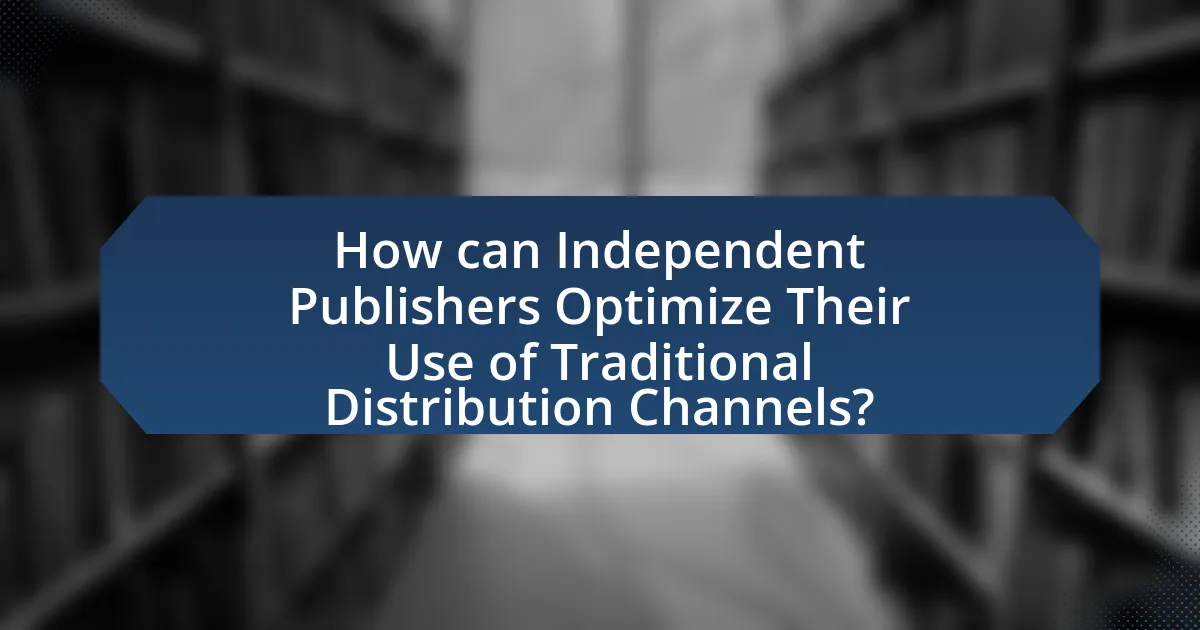
How can Independent Publishers Optimize Their Use of Traditional Distribution Channels?
Independent publishers can optimize their use of traditional distribution channels by establishing strong relationships with distributors and retailers. By actively engaging with distributors, independent publishers can negotiate better terms, gain insights into market trends, and ensure their titles are prominently displayed. Additionally, leveraging local bookstores and libraries can enhance visibility and foster community support, as studies show that local engagement increases sales by up to 30%. Furthermore, participating in book fairs and industry events allows independent publishers to showcase their titles directly to retailers and consumers, further enhancing their market presence.
What are the best practices for selecting distribution partners?
The best practices for selecting distribution partners include evaluating their market reach, assessing their reputation, and ensuring alignment with your brand values. Market reach is crucial; partners with established networks can significantly enhance product visibility and sales. A partner’s reputation impacts your brand’s credibility; therefore, researching their history and customer feedback is essential. Additionally, alignment with brand values ensures that the partner’s practices resonate with your target audience, fostering a cohesive marketing strategy. According to a study by the Harvard Business Review, companies that prioritize alignment with distribution partners see a 30% increase in customer satisfaction and loyalty.
How can publishers evaluate potential distributors effectively?
Publishers can evaluate potential distributors effectively by assessing their distribution reach, reputation, and terms of service. Evaluating distribution reach involves analyzing the distributor’s network and ability to access target markets, which is crucial for maximizing sales. Reputation can be gauged through industry reviews, testimonials, and past performance metrics, ensuring that the distributor has a history of reliability and success. Additionally, examining the terms of service, including fees, payment schedules, and return policies, helps publishers understand the financial implications and risks involved. This comprehensive evaluation process allows publishers to make informed decisions that align with their distribution goals.
What factors should be considered when negotiating distribution agreements?
When negotiating distribution agreements, key factors include pricing structures, territory rights, and performance metrics. Pricing structures determine the financial terms, including discounts and payment schedules, which directly impact profitability for independent publishers. Territory rights specify the geographical areas where the distributor can sell the products, influencing market reach and competition. Performance metrics, such as sales targets and reporting requirements, ensure accountability and help assess the distributor’s effectiveness. These factors collectively shape the success of the distribution strategy and must be carefully evaluated to align with the publisher’s goals.
How can independent publishers leverage their unique strengths in traditional distribution?
Independent publishers can leverage their unique strengths in traditional distribution by emphasizing their niche markets and personalized relationships with retailers. These publishers often have the agility to adapt quickly to market trends, allowing them to curate specialized content that appeals to specific audiences. For instance, independent publishers can build strong connections with local bookstores, which often prefer to stock titles that resonate with their community, thereby increasing visibility and sales. Additionally, independent publishers can utilize targeted marketing strategies that highlight their unique offerings, such as author events or community engagement initiatives, which can enhance their presence in traditional distribution channels. This approach not only differentiates them from larger publishers but also fosters loyalty among readers and retailers alike.
What niche markets can independent publishers target through traditional channels?
Independent publishers can target niche markets such as local history, specialized hobbies, and underrepresented voices through traditional channels. These markets often have dedicated audiences that seek specific content not widely available from mainstream publishers. For example, local history books can attract community interest and support from local bookstores and libraries, while specialized hobbies like knitting or model building can be marketed through niche retailers and hobby shops. Additionally, underrepresented voices, including works by marginalized authors, can find a receptive audience in independent bookstores that prioritize diversity and inclusion. This targeting strategy is supported by the growing trend of consumers seeking unique and authentic content, as evidenced by the rise in sales of independent publications in these areas.
How can storytelling enhance the appeal of independent publications in traditional distribution?
Storytelling enhances the appeal of independent publications in traditional distribution by creating a deeper emotional connection with readers. This connection can lead to increased engagement and loyalty, as narratives resonate with audiences on a personal level. For instance, independent publications that share authentic stories about their origins, mission, or the communities they serve can differentiate themselves from mainstream media, which often lacks such personal touches. Research indicates that storytelling can increase information retention by up to 65%, making it a powerful tool for independent publishers to capture and maintain reader interest. By leveraging storytelling, these publications can effectively communicate their unique value propositions, thereby improving their chances of success in traditional distribution channels.
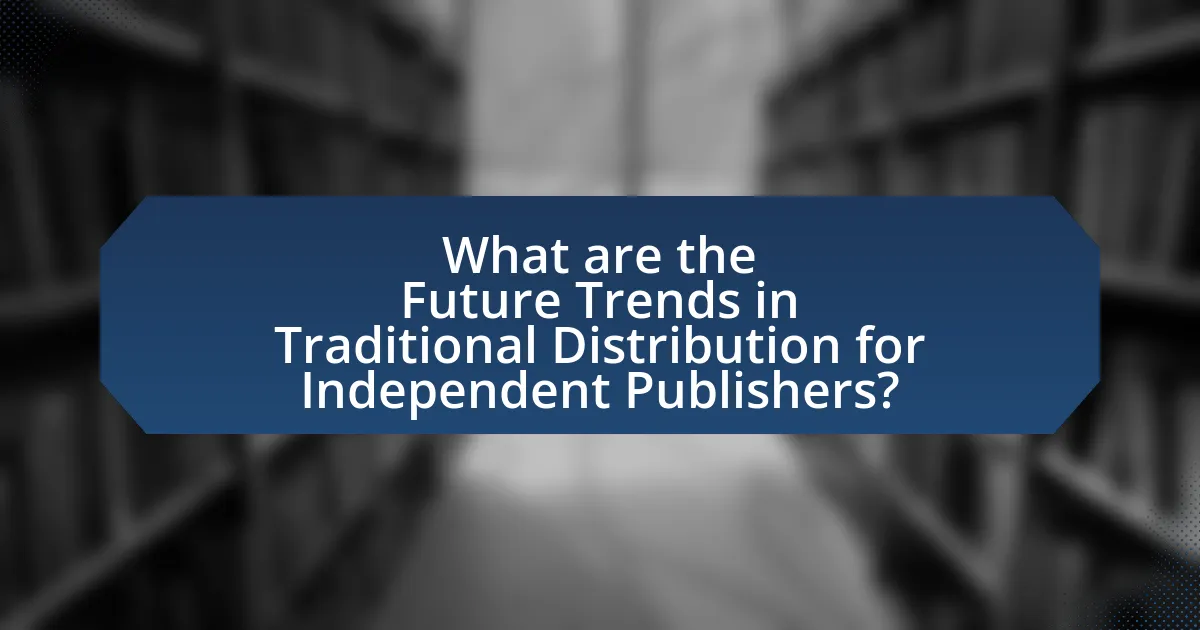
What are the Future Trends in Traditional Distribution for Independent Publishers?
Future trends in traditional distribution for independent publishers include increased collaboration with niche distributors, a focus on direct-to-consumer sales, and the integration of technology to streamline distribution processes. Independent publishers are increasingly partnering with specialized distributors who understand their unique market needs, allowing for more targeted outreach and better placement in bookstores. Additionally, the rise of e-commerce has prompted these publishers to prioritize direct sales through their websites and social media platforms, enhancing their connection with readers. Furthermore, advancements in technology, such as inventory management systems and data analytics, are enabling independent publishers to optimize their distribution strategies, ensuring they can respond quickly to market demands and consumer preferences. These trends reflect a shift towards more agile and consumer-focused distribution models in the independent publishing sector.
How is technology influencing traditional distribution channels?
Technology is significantly transforming traditional distribution channels by enhancing efficiency, accessibility, and data-driven decision-making. For instance, the rise of e-commerce platforms allows independent publishers to reach a global audience without the constraints of physical distribution, thereby increasing market reach. Additionally, tools like inventory management software streamline operations, reducing costs and improving order fulfillment times. Data analytics enables publishers to understand consumer preferences and optimize their distribution strategies accordingly, leading to more targeted marketing efforts. According to a report by McKinsey, companies that leverage digital tools in their distribution processes can achieve up to a 30% increase in operational efficiency.
What role do digital tools play in enhancing traditional distribution?
Digital tools significantly enhance traditional distribution by streamlining processes, improving communication, and expanding reach. For instance, platforms like social media and e-commerce websites allow independent publishers to connect directly with their audience, bypassing traditional gatekeepers. Additionally, tools such as inventory management software and data analytics enable publishers to optimize stock levels and understand consumer preferences, leading to more efficient distribution strategies. According to a study by the Pew Research Center, 79% of consumers have made an online purchase, highlighting the importance of digital channels in reaching a broader market.
How can independent publishers adapt to changing consumer behaviors?
Independent publishers can adapt to changing consumer behaviors by leveraging digital platforms and data analytics to understand and meet audience preferences. By utilizing tools like social media, email marketing, and e-commerce, publishers can engage directly with consumers, tailoring content and marketing strategies to reflect current trends. For instance, a report from the Pew Research Center indicates that 79% of adults in the U.S. have purchased a book online, highlighting the importance of an online presence. Additionally, analyzing consumer data allows publishers to identify popular genres and formats, enabling them to adjust their offerings accordingly. This proactive approach ensures that independent publishers remain relevant and competitive in a rapidly evolving market.
What insights can independent publishers gain from industry case studies?
Independent publishers can gain valuable insights from industry case studies by analyzing successful strategies and challenges faced by their peers. These case studies provide concrete examples of effective distribution methods, marketing techniques, and audience engagement practices that have been tested in real-world scenarios. For instance, a case study on a small press that successfully utilized social media to boost book sales can illustrate the importance of digital marketing in reaching target audiences. Additionally, examining case studies can reveal common pitfalls, such as over-reliance on a single distribution channel, allowing independent publishers to avoid similar mistakes. By leveraging these insights, independent publishers can make informed decisions that enhance their distribution strategies and overall business performance.
What successful examples exist of independent publishers navigating traditional distribution?
Successful examples of independent publishers navigating traditional distribution include Graywolf Press and Coffee House Press. Graywolf Press has established strong relationships with major distributors like Ingram, allowing them to reach a wide audience while maintaining their independent identity. Coffee House Press has successfully utilized a hybrid model, combining traditional distribution with direct sales through their website, which has enabled them to retain a significant portion of their revenue. These strategies demonstrate how independent publishers can effectively leverage traditional distribution channels while preserving their unique voices and business models.
How can lessons learned from these examples be applied to new strategies?
Lessons learned from examples in navigating traditional distribution channels can be applied to new strategies by emphasizing adaptability and leveraging established relationships. Independent publishers can analyze successful case studies to identify effective practices, such as building partnerships with distributors and utilizing data-driven marketing approaches. For instance, a study by the Independent Book Publishers Association highlights that publishers who actively engage with their distribution partners see a 30% increase in sales compared to those who do not. By adopting these insights, independent publishers can refine their strategies to enhance visibility and market reach.
What practical tips can independent publishers implement for successful traditional distribution?
Independent publishers can implement several practical tips for successful traditional distribution, including building strong relationships with distributors, understanding market trends, and optimizing inventory management. Establishing connections with distributors ensures better access to retail channels, while staying informed about market trends allows publishers to align their offerings with consumer demand. Additionally, effective inventory management helps prevent overstock and stockouts, which can hinder sales. According to a 2021 survey by the Association of American Publishers, publishers who actively engage with their distribution partners report a 30% increase in sales efficiency.
